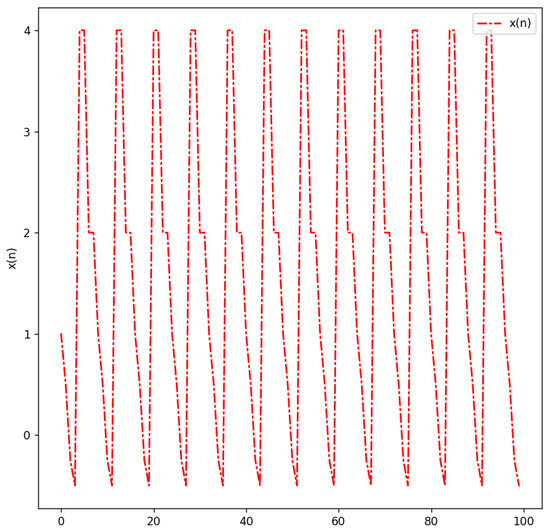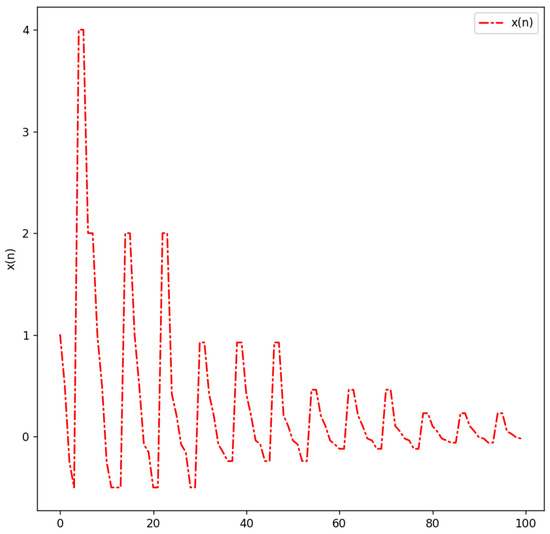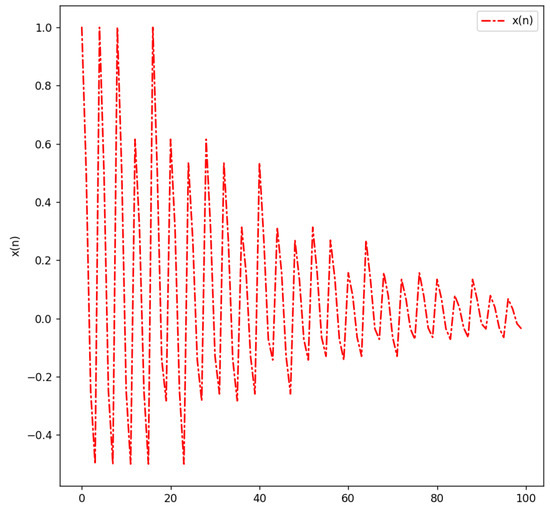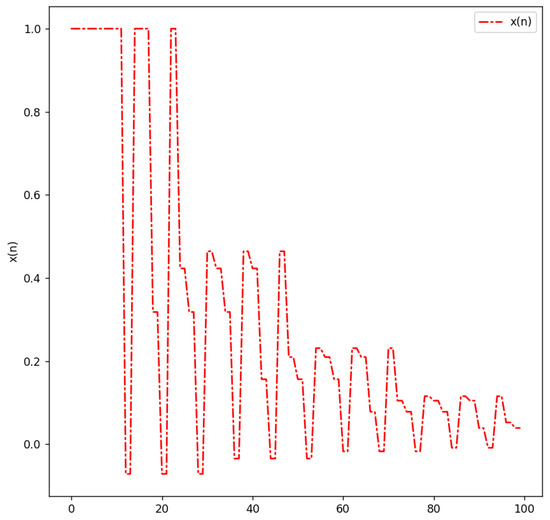Abstract
The invariance method, known as Lie analysis, consists of finding a group of transformations that leave a difference equation invariant. This powerful tool permits one to lower the order, linearize and more importantly, obtain analytical solutions of difference and differential equations. In this study, we obtain the solutions and periodic solutions for some family of difference equations. We achieve this by performing an invariance analysis of this family. Eventually, symmetries are derived and used to construct canonical coordinates required for the derivation of the solutions. Moreover, periodic aspects of these solutions and the stability character of the equilibrium points are investigated.
MSC:
39A10; 39A13; 39A23; 39A05; 39A99
1. Introduction
In certain cases, difference equations are used to model the evolution of natural phenomena occurring over time. The analysis of difference equations has attracted the attention of many researchers and interesting results have been obtained. The type of difference equations where initial conditions and parameters appearing in the equations are fuzzy numbers, known as fuzzy difference equations, have also been studied and progress has been made [1,2]. In numerous articles that dealt with solutions of difference equations, we noticed the use of proof by induction to show that the presented formulas for the solutions are valid. To the best of our knowledge, the use of Lie analysis to obtain analytic solutions to difference equations is to some extent new. This method, originally applied to differential equations, has recently been applied to difference equations. It traces back to the twentieth century when Maeda [3] proved that, as long as a difference equation admits symmetries, its order can be reduced. Recently, it has been shown, for differential equations, that when symmetries and conservation laws are associated, one may proceed to double reduction [4]. It is now known that this approach works for difference equations [5]. With regard to differential equations, computer packages that generate Lie symmetries have been developed. Regrettably, this is not the case for difference equations. Symmetries of difference equations are mostly computed by hand and frequently involve cumbersome computations.
In this study, unlike in many articles where the change of variables is made by guess work, we employ symmetries to reduce the order of the difference equation
via canonical coordinates. We clearly state the link between the symmetries (characteristics) and the new variable (invariant). Note that in (1), and are real sequences and , are the initial conditions. As a matter of choice, some authors prefer the equivalent form
of (1). Studies of special cases of (2) can be found in the literature [6] where the authors consider the equation
and presented the formula for solutions as well as their asymptotic behavior. For similar studies on difference equations of this form, the reader can refer to [5,6,7,8,9,10,11,12].
The paper is organized as follows. In Section 2, we provide some basic theory needed for finding symmetries of difference equations and the reduction of order. We also discuss some well-known theory on the stability of equilibrium points. In Section 3, we obtain symmetries and solutions of (1). A more detailed study is conducted for some special cases. Section 4 is mainly dedicated to the stability of the equilibrium points and the periodicity aspects of the solutions of (1). Finally, in Section 5, we show that some existing results in the literature are special cases of our findings.
2. Preliminaries
The algorithm for finding symmetries of difference equations is explained at large in [13]. Consider an equation involving some continuous variables and a local diffeomorphism (point transformation): .
Definition 1.
A parameterized set of transformations
is a one-parameter local Lie group of transformations if the following conditions are satisfied:
- 1.
- is the identity map, so that when .
- 2.
- for every sufficiently close to 0.
- 3.
- Every can be represented as a Taylor series in ε, that is,
Definition 2.
The infinitesimal generator of the one-parameter Lie group of point transformations (4) is the operator
and Δ is the gradient operator.
Theorem 1
([13]). is invariant under the group of transformations (4) if and only if .
Suppose a difference equation has the form
where is a known function that satisfies . As said before, we explore a one-parameter Lie group of point transformations
where represents the group parameter. The function is referred to as the characteristic of the Lie group. The infinitesimal generator takes the form
Although the transformation depends on n and only, one needs to investigate how the symmetries affect the other variables appearing in the right hand side of (6), hence the introduction of the prolonged infinitesimal generator X of :
admitted by the group of transformations (7). Accordingly, the infinitesimal condition for invariance is given by , that is,
on condition that (6) is satisfied. The functional Equation (9) can be solved for Q after a set of lengthy computations.
The analysis of stability of the equilibrium points will be carried out using the following definitions and theorems. They can be found in [14].
Definition 3.
Definition 5.
We introduce the characteristic equation of (6) of the fixed point :
where
Theorem 2
([14]). Suppose is a smooth function defined on some neighborhood of . Then,
Definition 6.
Theorem 3
([14]). Assume and are real numbers such that
Then, the roots of (10) lie inside the open unit disk .
3. Symmetries and Solutions
We differentiate (11) with respect to viewing as a function of , , , , and . To put it in another way, we apply the differential operator to (11) to obtain (after clearing fractions except for the reciprocal of ):
Observe that denotes the derivative of with respect to x and represents the derivative with regard to the continuous variable. Next, we differentiate (12) with respect to and we utilize the method of separation to obtain the following system:
It is easy to verity that the general solution of the above system is given by
for some arbitrary functions and depending on n. We replace (14) and the corresponding shifts in (11) ( must also be replaced by its expression in (1)). Clearing fractions and separating with respect to products of , the resulting system of equations reduces to the constraints:
The constraint in (16) is a homogeneous linear difference equation with characteristic equation whose solutions are , and for . Solutions of (16) take the form and using (8), we have symmetries given by
. We construct the canonical coordinate as
and we set
The variable can take the form
and, as a matter of fact, is an invariant because
Using (1) and (20), we derive the following relations:
and
from which are obtained
and
using simple iterations. Since we do not have an expression for , we make use of (25) to obtain the following:
Observe that the symbol represents the floor function and is the remainder after division of q by . It follows that . Employing (24) in (26), we find that
where . Equation (27) gives the solution to the difference Equation (1). Naturally, the solution of (2) is deduced from that of (1) by backshifting it times. So, using (27), the solution of (2) reads
where . For 1, k, -periodic sequences and , the solutions simplifies considerably. The following subsection is dedicated to the case where and are 1-periodic.
3.1. The Case and Are 1-Periodic Sequences
Letting and in (27), we obtain
. However, can take the form with ; ; . Consequently,
More explicitly,
for ; with . Equations in (31) are given in terms of the first terms including the initial conditions. Since one of the aims of the paper is to present the solution in closed-form, we use (1) to provide the expressions of , , as follows:
for .
3.1.1. The Case When
The case : For this case, after simplification, we have that
for .
3.1.2. The Case When
4. Periodicity and Behavior of the Solutions
Here, we study the periodicity of the solutions via the formula of the solutions obtained in the previous section and we look at stability of the equilibrium points.
Theorem 4.
The solution of
where and are real constants, is -periodic if and only if the initial conditions, , satisfy the following conditions:
- (i)
- .
- (ii)
- .
- (iii)
- or .
Proof.
Figure 1 shows the graph of (37) for with the initial conditions satisfying the three conditions in Theorem 4. As expected, the solution is 8-periodic.

Figure 1.
with , , , , , , , , , .
Figure 2 shows the graph of (37) for with the initial conditions not satisfying one of the three conditions in Theorem 4, condition to be specific.

Figure 2.
with , , , , , , , , , , , .
Theorem 5.
The solution of (37) is -periodic if and only if the initial conditions, , satisfy the following conditions:
- (i)
- (ii)
- (iii)
- .
Proof.
Figure 3 shows the graph of (37) for with the initial conditions satisfying the three conditions in Theorem 5. As expected, the solution is 4-periodic.

Figure 3.
with , , , , , , , .
Figure 4 shows the graph of (37) for with the initial conditions not satisfying condition in Theorem 5.

Figure 4.
with , , , , , , , .
Note that the solution of (37) is not k-periodic when the initial conditions satisfy and . In this case, we have a constant sequence. Nevertheless, all the initial conditions being the same does not guarantee the existence of 1-periodic (constant) sequences. We illustrate this in Figure 5 and Figure 6.

Figure 5.
with not satisfying .

Figure 6.
with satisfying .
5. Concluding Remarks
Although Equations (1) and (2) are the same, the solution of the later equation is obtained by backshifting the solution of the first equation times. For example, when and for constant coefficients, (2) becomes
and its solution, using (33) and (35), is given by (after backshifting 6 times and remembering that, in this case, )
when ; and
when . This special case was studied in [6]. In fact, setting and yields Theorem 2.1 and Corollaries 2.2 and 2.3 in [6].
Funding
This research received no external funding.
Data Availability Statement
Not applicable.
Conflicts of Interest
The author declares no conflict of interest.
References
- Alijani, Z.; Tchier, F. On the fuzzy difference equation of higher order. J. Comput. Complex. Appl. 2017, 3, 44–49. [Google Scholar]
- Khastan, A.; Alijani, Z. On the new solutions to the fuzzy difference equation xn+1=A+B/xn. Fuzzy Sets Syst. 2019, 358, 64–83. [Google Scholar] [CrossRef]
- Maeda, S. The similarity method for difference equations. IMA J. Appl. Math. 1987, 38, 129–134. [Google Scholar] [CrossRef]
- Kara, A.H.; Mahomed, F.M. Relationship between symmetries and conservation laws. Int. J. Theor. Phys. 2000, 39, 23–40. [Google Scholar] [CrossRef]
- Ndlovu, L.; Folly-Gbetoula, M.; Kara, A.H.; Love, A. Symmetries, Associated First Integrals, and Double Reduction of Difference Equations. Abstr. Appl. Anal. 2014, 2014, 490165. [Google Scholar] [CrossRef]
- Yazlik, Y.; Gungor, M. On the solvable of nonlinear difference equation of sixth-order. J. Sci. Arts 2019, 2, 399–414. [Google Scholar]
- Kara, M.; Yazlik, Y. On the solutions of the three-dimensional system of difference equations via recursive relations of order two and applications. J. Appl. Anal. Comput. 2022, 12, 736–753. [Google Scholar] [CrossRef]
- Almatrafi, M.B.; Alzubaidis, M. The solution and dynamic behaviour of some difference equations of seventh order. J. Appl. Nonlinear Dyn. 2021, 10, 709–719. [Google Scholar] [CrossRef]
- Folly-Gbetoula, M.; Mkhwanazi, K.; Nyirenda, D. On a study of a family of higher order recurrence relations. Math. Probl. Eng. 2022, 2022, 6770105. [Google Scholar] [CrossRef]
- Elsayed, E.M.; Ibrahim, T.F. Solutions and Periodicity of a Rational Recursive Sequences of Order Five. Bull. Malays. Math. Sci. Soc. 2015, 38, 95–112. [Google Scholar] [CrossRef]
- Folly-Gbetoula, M.; Nyirenda, D. A generalised two-dimensional system of higher order recursive sequences. J. Differ. Equ. Appl. 2020, 26, 244–260. [Google Scholar] [CrossRef]
- Mnguni, N.; Nyirenda, D.; Folly-Gbetoula, M. Symmetry Lie Algebra and Exact Solutions of Some fourth-order Difference Equation. J. Nonlinear Sci. Appl. 2018, 11, 1262–1270. [Google Scholar] [CrossRef]
- Hydon, P.E. Difference Equations by Differential Equation Methods; Cambridge University Press: Cambridge, UK, 2014. [Google Scholar]
- Grove, E.A.; Ladas, G. Periodicities in Nonlinear Difference Equations; Chapman & Hall/CRC: Boca Raton, FL, USA, 2005; Volume 4. [Google Scholar]
Disclaimer/Publisher’s Note: The statements, opinions and data contained in all publications are solely those of the individual author(s) and contributor(s) and not of MDPI and/or the editor(s). MDPI and/or the editor(s) disclaim responsibility for any injury to people or property resulting from any ideas, methods, instructions or products referred to in the content. |
© 2023 by the author. Licensee MDPI, Basel, Switzerland. This article is an open access article distributed under the terms and conditions of the Creative Commons Attribution (CC BY) license (https://creativecommons.org/licenses/by/4.0/).